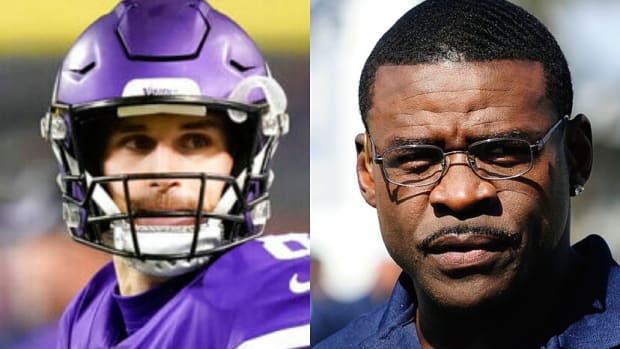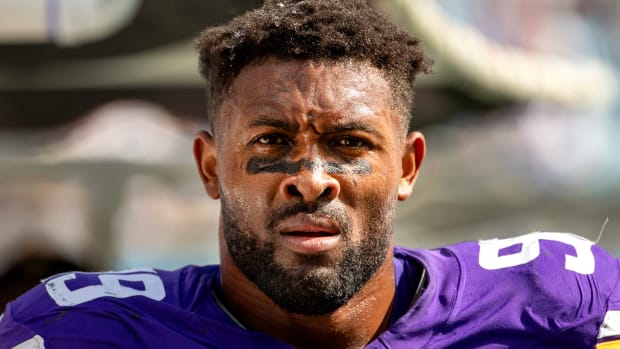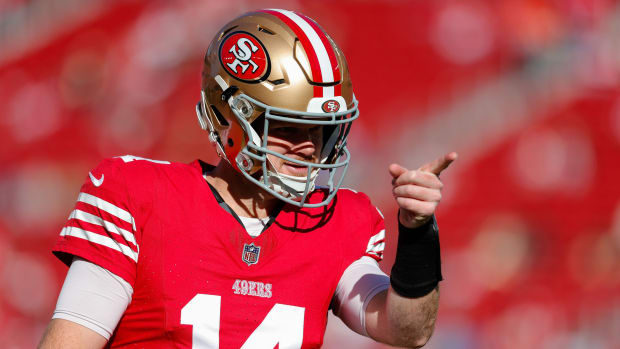The Cases For and Against the Vikings Trading For Trent Williams
With COVID-19 shutting down every other sports league in America, the NFL offseason has had little competition for the spotlight. That has led to an endless supply of rumors, discussions, and hypothetical moves circulating the internet, whether they're backed by any credible reporting or not. What else is there to do while social distancing than speculate on trades and do simulated mock drafts?
When it comes to the Vikings, the central discussion point right now is Trent Williams. Specifically, what it would take for Rick Spielman and Minnesota to acquire the seven-time Pro Bowler who is widely regarded as one of the best offensive tackles in football.
This isn't just some fun, baseless rumor. The pieces make sense, and there's legitimate reason to believe discussions have been had. Williams wants the Redskins to trade him; that has been made very clear by his agent. He has seemingly wanted out of that organization for some time, having sat out all of 2019 due to contract disputes and frustration over the team's handling of a major medical issue. Meanwhile, the Vikings are in perpetual need of more talent on their offensive line. Most importantly, several credible sources – including ESPN's John Keim and KSTP's Darren Wolfson – have reported that the Vikings have shown interest in acquiring Williams.
There's no question that a trade for Williams would make the Vikings' offensive line better in 2020 and beyond. In the end, whether or not a deal happens will come down to the compensation needed to pry him from the Redskins and the cost of signing him to a long-term deal. There are a ton of factors in play: the Vikings' lack of cap space, decisions on Anthony Harris and Riley Reiff, Williams' contract demands, and the Redskins' leverage (or lack thereof).
For now, let's just approach this from Minnesota's perspective. We'll examine the case for the Vikings going all-in on making a Williams trade happen, and the case for steering clear.
Why the Vikings should pursue a trade for Trent Williams
Simply put, Williams would be the best tackle the Vikings have had since Gary Zimmerman left for the Broncos in 1993. He'd be a massive, immediate upgrade over Reiff, who would likely have to be cut or included in the trade (creating $8.8 million in cap space) in order for the Vikings to afford Williams. Before sitting out last season, Williams was a Pro Bowler for seven straight years, three of those with Kirk Cousins as his quarterback.
When he's healthy and playing at his best, one can make the argument that Williams is the best offensive lineman in the NFL. At 6'5", 320 pounds, with a decade of experience perfecting his craft, he's an immovable object in pass protection and a wrecking ball as a run-blocker. Williams could easily fit in the Vikings' zone-blocking scheme with his off-the-charts athleticism; he ran a 4.88 40-yard dash and jumped out of the gym at the 2010 combine. Williams' 40 time ranks in the 98th percentile among offensive linemen, his vertical jump is in the 97th percentile, and his broad jump is in the 94th percentile.
Read: Could Cesar Ruiz Be a Surprise First-Round Option for the Vikings?
Concerns about his age also shouldn't be a reason for the Vikings not to push for a trade. Williams turns 32 in June, but he plays a position where plenty of players have been successful deep into their 30s, with Jason Peters and Andrew Whitworth being two recent examples. Williams could hold down the left side of the Vikings' line for the next five-plus years, forming one of the league's best duos with right tackle Brian O'Neill. He'd give Cousins the time in the pocket he needs to be at his best, and would be a dominant force in the running game.
Left tackle is one of the most important positions in football, and Williams has a long track record of playing at an elite level. If the Vikings can clear enough space to pay him, they should be pursuing every possible avenue to make a trade happen.
Why the Vikings shouldn't pursue a trade for Trent Williams
For as talented as Williams is, there are a plethora of reasons for Spielman to approach this situation cautiously.
First of all, here's an estimation of the minimum cost: Reiff, a third-round pick, and a late-round pick going to Washington in a trade, and $15 million per year going to Williams on a contract extension. Again, that's a conservative estimate. It might take a second-round pick to get the Redskins to budge, even if the discussion of how much leverage they hold against Williams is an interesting one. And Williams, who has one year left on a contract set to pay him $12.5 million in 2020, may want as much as $18 million annually in an extension, which would be a massive commitment for the Vikings given their financial situation.
Trading for Williams would be a clear win-now move for a team that has straddled the line between contending and rebuilding this offseason. Would it be worth it for the Vikings to make such a huge financial commitment to a player like Williams after losing Stefon Diggs, Trae Waynes, Everson Griffen, and several other key pieces over the past few weeks?
Then there's the Harris situation to consider. Trading their star safety and freeing up the $11.4 million he's currently owed on the franchise tag would be a big step towards creating space to sign Williams, but that would be another major loss on the defensive side of the ball with no clear replacement in waiting. There's really no imaginable scenario where the Vikings can pay both Harris – who is seeking a long-term deal – and Williams going forward. Trading Reiff and cutting a few other players could create the room for the Vikings to pay Williams and keep Harris on the tag, but that would just delay a decision on his long-term status for a year. Even though left tackle is an inherently more valuable position than safety, Spielman would have to grapple with the possibility of landing Williams but starting several rookies in the secondary in 2020.
Read: Assessing the Vikings' Receiver Group After Adding Tajae Sharpe
Lastly, it must be noted that there's some risk that would come with making a blockbuster move for Williams. He's almost 32, missed a full season last year, and before that missed 15 games in four years due to suspension and injury. Williams has also had a couple off-the-field incidents and received the lowest PFF grade of his career in 2018, his most recent season.
Spielman might wind up deciding that Williams' talent and positional value outweigh all of the costs and concerns. He also might not come to that conclusion. All we can do right now is stay home, wash our hands, and continue to imagine the possibilities.
Join the conversation at InsideTheVikings by clicking the follow button in the upper right-hand corner of this page, and follow @WillRagatz on Twitter.




